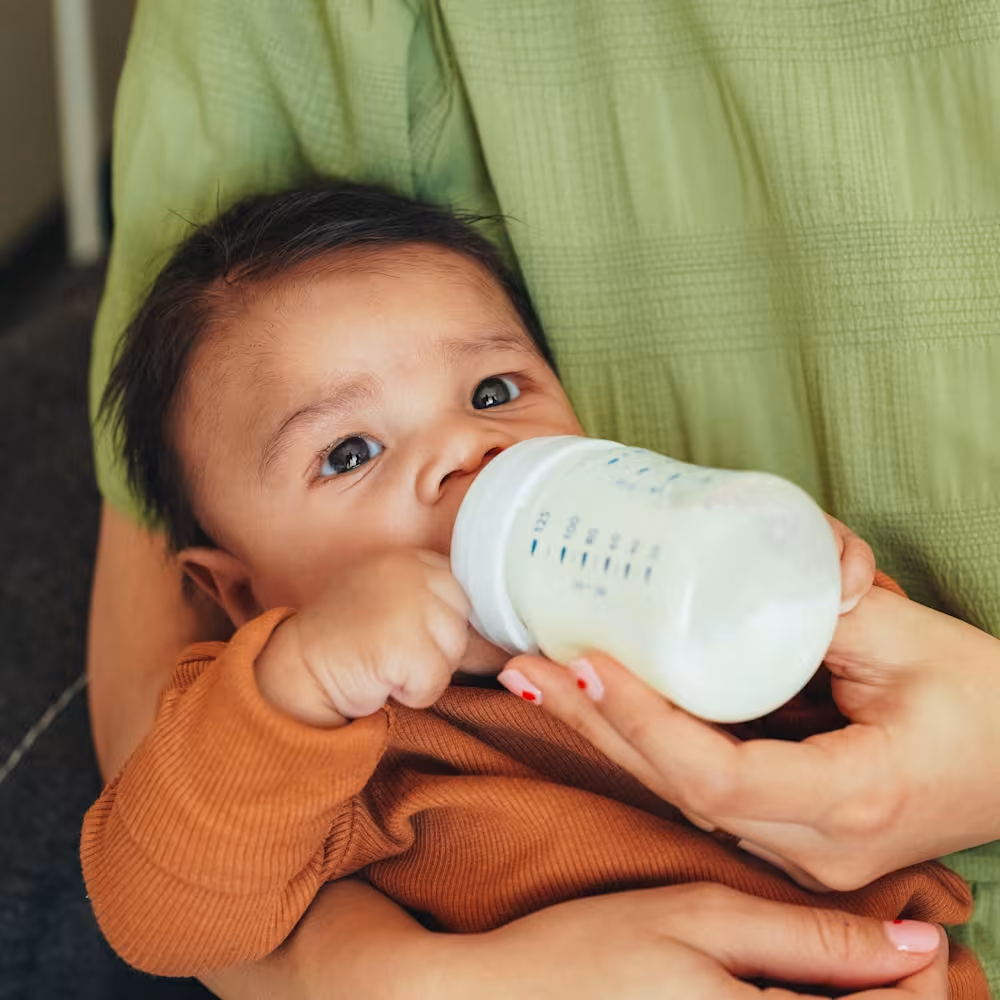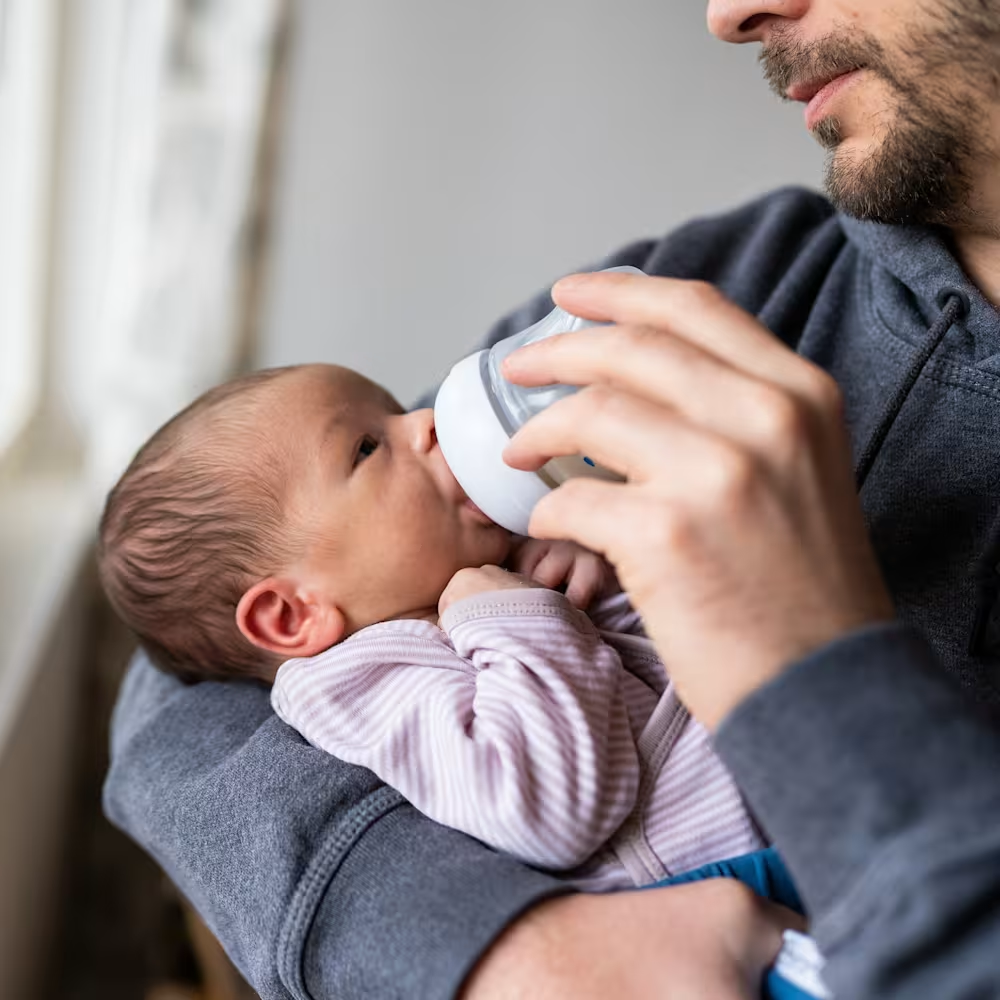Can you freeze breast milk?
Updated Jan 02, 2026

Whether you pumped more than your baby needs for a feeding or intentionally pumped for more breast milk, you may find yourself with extra milk at some point during your breastfeeding and pumping journey. No matter the reason, moms often want to save that milk to use another time — you worked hard for it and it can feed your little one later!
If you're a lactating mom, you have options for storing your breast milk. For short-term storage, you can refrigerate breast milk. But if you have extra milk you'd like to save for longer than four days, you can safely freeze breast milk if you follow proper milk storage guidelines. In this article, we’ll give you tips for safely and efficiently freezing breast milk, give you the lowdown on milk storage guidelines, and answer frequently asked questions about the process.
How to thaw and use frozen breast milk
Benefits of freezing breast milk
There isn’t a universal reason to pump and freeze breast milk — everyone’s breastfeeding journey is different. While there is no need to “feed your freezer” or feel pressure to have a freezer full of milk, freezing breast milk has its perks, including:
It can give you more flexibility
It can provide peace of mind
It may help you meet your breastfeeding goals
Reasons moms may look to freeze breast milk
Here are some common reasons to freeze breast milk:
You expressed extra and you don’t want it to go to waste
You want to build a freezer stash (to have extra or to meet a breastfeeding goal early)
You’re going to be away from your baby (e.g. you’re going back to work or out of town)
You’re an overproducer and routinely pump more than your baby consumes
You want to donate breast milk
You’re worried about your supply suddenly dropping due to latching issues, pregnancy, or returning to work
You want a backup or cushion in the event of an emergency
You know having extra will help your mental health
You want to save breast milk to use in recipes when your baby starts solids
You want others to be able to help feed your baby
How can you safely freeze breast milk?
Freezing breast milk to use at a later date is often a straightforward process, especially once you get into the swing of it. Although moms develop their systems and routines with slight variations, it's important to follow proper milk storage guidelines:
How to freeze breast milk
These step-by-step instructions will help you safely freeze — and store — breast milk for later use.
Start with clean hands (and pump parts)
Wash your hands with soap before pumping, hand expressing, or pouring batches of pooled or refrigerated breast milk to freeze in another container. It's always best to start with clean hands (and pump parts) before expressing or handling breast milk.
Use the right containers
Whether you’re refrigerating or freezing your breast milk, Mayo Clinic [] suggests storing it in:
Capped food-grade glass containers
Capped hard plastic containers that are free from the chemical bisphenol A (BPA)
Plastic bags specifically designed for breast milk storage
Things to keep in mind:
Just like your hands, always make sure your bottles are clean first
Don't store breast milk in disposable bottle liners
Don’t use plastic bags designed for general household use
Make sure the containers have tight-fitting lids
Label your storage bag or container
Before pouring any milk, label the storage bag or container with the date it was collected or frozen. It's easier to write on the bags when they’re empty and this helps avoid accidental spills with filled containers. You can either use the date the milk was expressed or the date it was frozen (if different). Aim to be consistent as you establish a system — your future self will thank you!
Also consider writing the number of ounces in each bag or container so you know how much you’re defrosting later. If your child is in daycare, include their name and check with their teacher or director to see if they have any specific labeling or storage requirements.
Be strategic with how much you pour
Freeze breast milk in small amounts to help avoid defrosting more than you need and potentially wasting it. If you pump a large amount of milk, you may want to split it into multiple bags, even if it could all fit in one. Any breast milk your baby doesn't finish during a feeding should be used within 2 hours or can be used for the next feeding if immediately refrigerated, explains the American Academy of Pediatrics (AAP) []. Any thawed milk that’s unused should be consumed or thrown away within 24 hours of completely defrosting.
For this reason, consider pouring as much as your baby typically drinks per feeding in each container to freeze. Depending on your little one's age or when you aim to use the milk, this could mean pouring 2 to 5 ounces per bag. If you pump directly into milk storage bags, still take note of the total volume collected and pour to store accordingly. Some parents also find it easier to pour the same amount into each bag or container. That way, you know exactly how many bags to grab from the freezer later without doing much mental math.
Move it to the freezer
The AAP recommends freezing, instead of refrigerating, any breast milk you won’t use within 48 - 72 hours and placing it in the back of your freezer (if an upright freezer). Aim to store it as far away from the freezer door as you can to help keep the temperature as consistently cold as possible.
Tips for freezing breast milk
These breast milk storage tips help make the process easier for you — and the milk safe for baby.
Tip # 1: Use recommended storage temperatures
The AAP recommends storing freshly expressed breast milk according to these temperatures and timeframes []:
Room temperature: Freshly expressed breast milk can be left out at room temperature — up to 77°F (25°C) — for up to 4 hours (or up to 8 hours “if very cleanly expressed.”) However, it’s ideal to refrigerate or freeze it when you can, instead of leaving it out.
Refrigerator: Breast milk can be refrigerated or chilled to 39°F (4°C) for up to 4 days, according to the AAP. However, Mayo Clinic advises that 3 days is optimal. Keep your breast milk in the back of the refrigerator instead of the door or at the front to help keep it at a consistent temperature.
Freezer: Breast milk can be stored for up to 9 months if your freezer is set to 0°F ( −18°C).
Chest or a deep freezer: Breast milk frozen and stored in this type of freezer at −4°F (−20°C) can be kept the longest. You can keep milk frozen for up to 12 months (but using within the first 6 months is optimal, according to Mayo Clinic []).
Tip #2: Maximize freezer storage space
Sometimes, storing breast milk can feel like playing Tetris in your freezer. To maximize space and help keep things organized, use storage bags and freeze them lying flat. Some people even place them on a cookie sheet in the freezer initially. Once the breast milk is frozen, you can stack the bags and put them in a Ziplock gallon-sized bag to make what some call "breast milk bricks." Then, you can label the gallon bag/brick with the month or date range. This can help you use older milk first when you go to defrost it. You can also write the total number of ounces in your brick to help keep track of how many ounces you have if you're working towards a total ounce goal.
Tip #3: Get it chilled
Refrigerate or freeze any extra breast milk as soon as possible to avoid bacteria growth. Although freshly expressed milk can safely stay at room temperature (up to 77°F) for 4 hours or 6 - 8 hours if "very cleanly expressed," the AAP says it's still best to chill it as soon as possible. If you don't have time to freeze the milk immediately or aren't sure if you'll need it, you can always refrigerate it first and then freeze.
Tip #4: Don’t fill containers too full
Keep in mind that breast milk expands when it freezes. Check your storage bottle or bag for a maximum fill line, and don't fill past it (even if there's extra room). If there isn't one marked, avoid pouring to the very top. When a storage container is filled too full and the milk expands, the bag may tear or burst at the seam, leading to wasted milk and a big mess!
Tip #5: Consider keeping morning and evening milk separate
To help encourage sleep, consider keeping milk pumped during different times of day separate (i.e., AM v. PM) and labeled according to whether it was expressed in the morning or evening. Then, defrost milk according to the time of day you’ll be feeding it to your little one. Feeding evening milk before bed may help support a baby’s circadian rhythm []. Evening breast milk contains higher levels, signaling to a baby’s body that it’s time to wind down and get ready for sleep.
Since babies produce little melatonin in their early months, this “chrononutrition”— aligning milk with day-night cycles — can be especially helpful for setting sleep patterns and promoting healthy development.
How to safely thaw and use frozen breast milk
“Pooling”
Some moms who pump multiple times a day find it easier to freeze milk in batches instead of after each session. But this can quickly fill your refrigerator with small milk bottles. To help minimize the clutter and streamline the process, some moms opt for the “pooling” or “pitcher” method, where they pour freshly pumped breast milk into one larger container and continue to add milk to it after each session. Then, when they are ready to freeze that batch, they pour it into freezer bags or breast milk containers at the same time.
Best practices for pooling breast milk include:
Keep the container in the back of your refrigerator to avoid temperature fluctuations
Use or freeze the stored milk within 4 days
Avoid combining breast milk at two different temperatures, according to Mayo Clinic []
Instead, chill freshly expressed breast milk first before adding it to milk that's already refrigerated. (Adding warm breast milk to already frozen milk may cause it to thaw partially.)
Go by the oldest date — if pooling cooled milk pumped on different days, base the storage date on when the older milk was first expressed, per the Centers for Disease Control and Prevention (CDC) []
Milk temperature before freezing
Breast milk can be put directly in the freezer without chilling it beforehand. However, you should chill freshly expressed milk first if you plan on pooling it with other refrigerated milk to store before eventually freezing it, per Mayo Clinic [].
Freezing after it’s been sitting out
Freshly expressed breast milk can stay at room temperature for up to 8 hours, according to the AAP []. However, it’s best to use or store breast milk (either in the freezer or refrigerator) within 4 hours.
Freshly expressed breast milk can stay in a refrigerator for up to 4 days but it’s ideal to use or freeze it within 3 days.
Refreezing breast milk after it’s been thawed isn’t advised. Experts often recommend using thawed milk within 24 hours and throwing out any leftovers instead of refreezing it. More research is needed on whether previously frozen breast milk is safe to consume after being refrozen and thawed again, according to Mayo Clinic. When you’re ready to thaw breast milk, it’s best practice to start with the oldest milk first since the quality of breast milk deteriorates over time.
Safe methods for thawing breast milk
To thaw frozen breast milk, the AAP recommends []:
Putting the bottle or bag in the refrigerator overnight
Holding it under warm running water
Placing the frozen bottle or bag it in a container of warm water
Sometimes, fat separates within chilled or thawed breast milk and sticks to the bottle or bag. The CDC suggests swirling the container to reincorporate the fat before pouring. Remember, once breast milk is thawed, it’s best to use it within 24 hours. The 24-hour countdown starts when the breast milk is completely thawed, not when you remove it from the freezer. Note that the AAP has less stringent recommendations and deems it’s safe to use within 48 - 72 hours.
How to warm up thawed milk
Similar to warming up refrigerated breast milk, the AAP suggests:
Putting the bottle in a bowl of warm water
Holding the bottle under running warm water
If using an electric milk warmer, follow the product’s heating instructions. No matter which method you choose, never use a microwave to warm breast milk. Microwaving breast milk is dangerous because it can scald your baby. According to Mayo Clinic [], some research shows rapidly heating breast milk can also affect the milk's antibodies.
How long frozen breast milk lasts after thawing
Previously frozen breast milk is best used within the first 24 hours but may be used up to 72 hours after being thawed if stored correctly in the refrigerator, according to the AAP.
| Location | Temperature | How long | Additional info |
|---|---|---|---|
| Room temperature (counter, table) | Up to 77°F (25°C) | Up to 4 hours (or up to 8 hours “if very cleanly expressed,” according to the AAP) | It’s still better to chill milk as soon as you can instead of leaving it out |
| Refrigerator | 39°F (4°C) | Up to 4 days, according to the AAP. (But Mayo Clinic advises that 3 days is optimal) | Store it in the back to help keep it at a consistent temperature |
| Freezer | 0°F ( −18°C) | Up to 9 months, according to the AAP. (But 6 months is optimal) | Keep it in the back, as far away from the freezer door as possible |
| Deep freezer | −4°F (−20°C) | Up to 12 months. (But 6 months is optimal, according to Mayo Clinic) | Breast milk frozen and stored in this type of freezer can be kept the longest |
| Previously frozen and thawed | Refrigerated if not used | Up to 24 hours according to the CDC. (Or, 48 - 72 hours if properly refrigerated, per the AAP) | The 24-hour countdown starts when the breast milk is completely thawed, not when it’s removed from the freezer. Refreezing breast milk after it’s been thawed isn’t advised. |
Takeaway
Freezing breast milk is a personal decision for every family. There are many reasons why someone might freeze their milk, including convenience and peace of mind.
It’s best to freeze milk in food-grade glass containers, BPA-free plastic containers, or plastic bags specifically designed for breast milk storage.
Freeze milk in small quantities depending on how much your baby consumes in one feeding and clearly label it with the date and number of ounces for future reference.
You can thaw breast milk by moving it to the refrigerator overnight, holding it under warm running water, or putting it in a container of warm water. Never microwave breast milk because it may heat unevenly and can burn your baby.
Once frozen breast milk is thawed, it’s best to use it within the first 24 hours, according to the CDC. (The AAP has less stringent recommendations and deems it’s safe to use within 48 - 72 hours if properly refrigerated.) Breast milk shouldn’t be refrozen.
Freezing breast milk FAQ
Share article:
Note: The content on this site is for informational purposes only and should not replace medical advice from your doctor, pediatrician, or medical professional. If you have questions or concerns, you should contact a medical professional.






